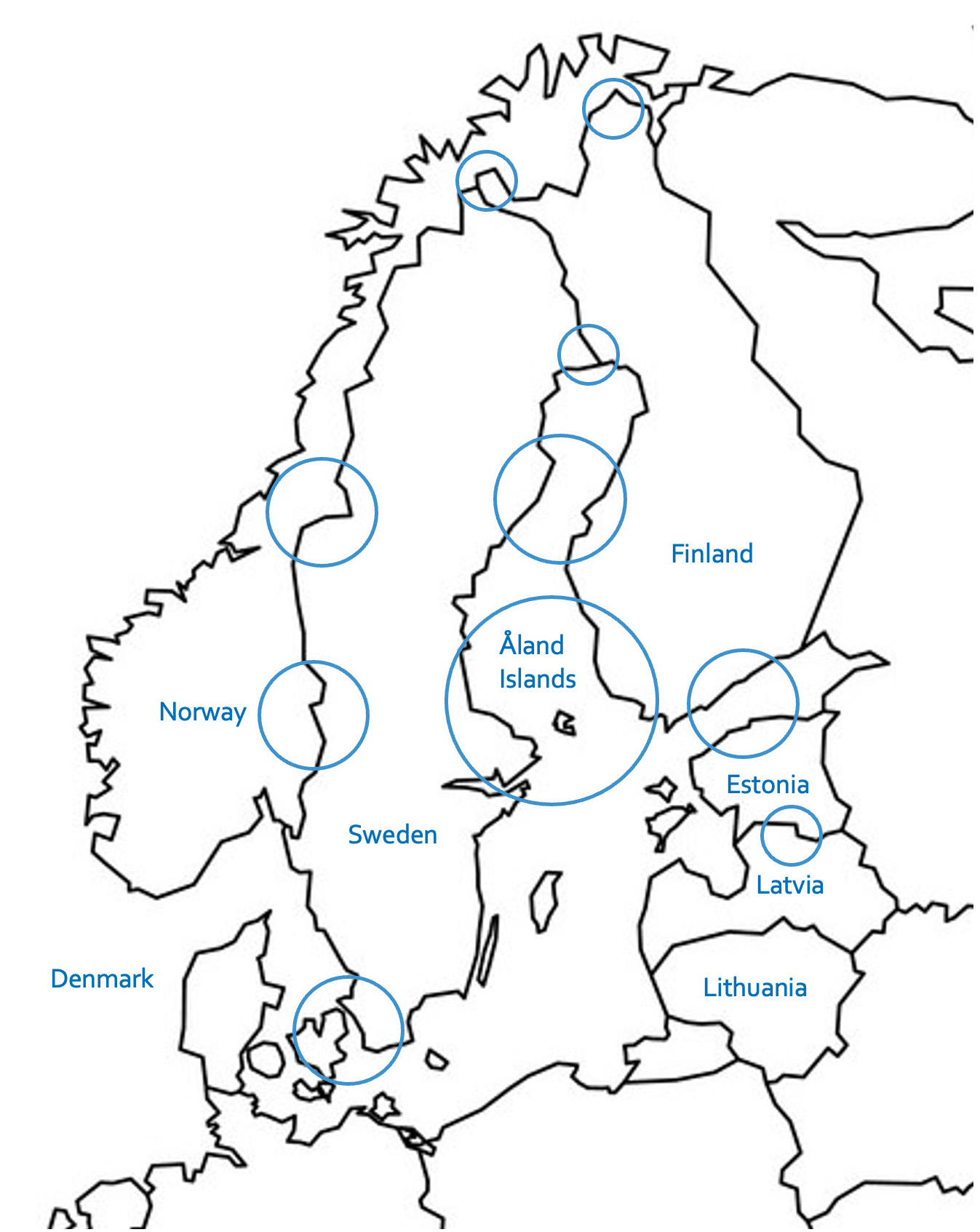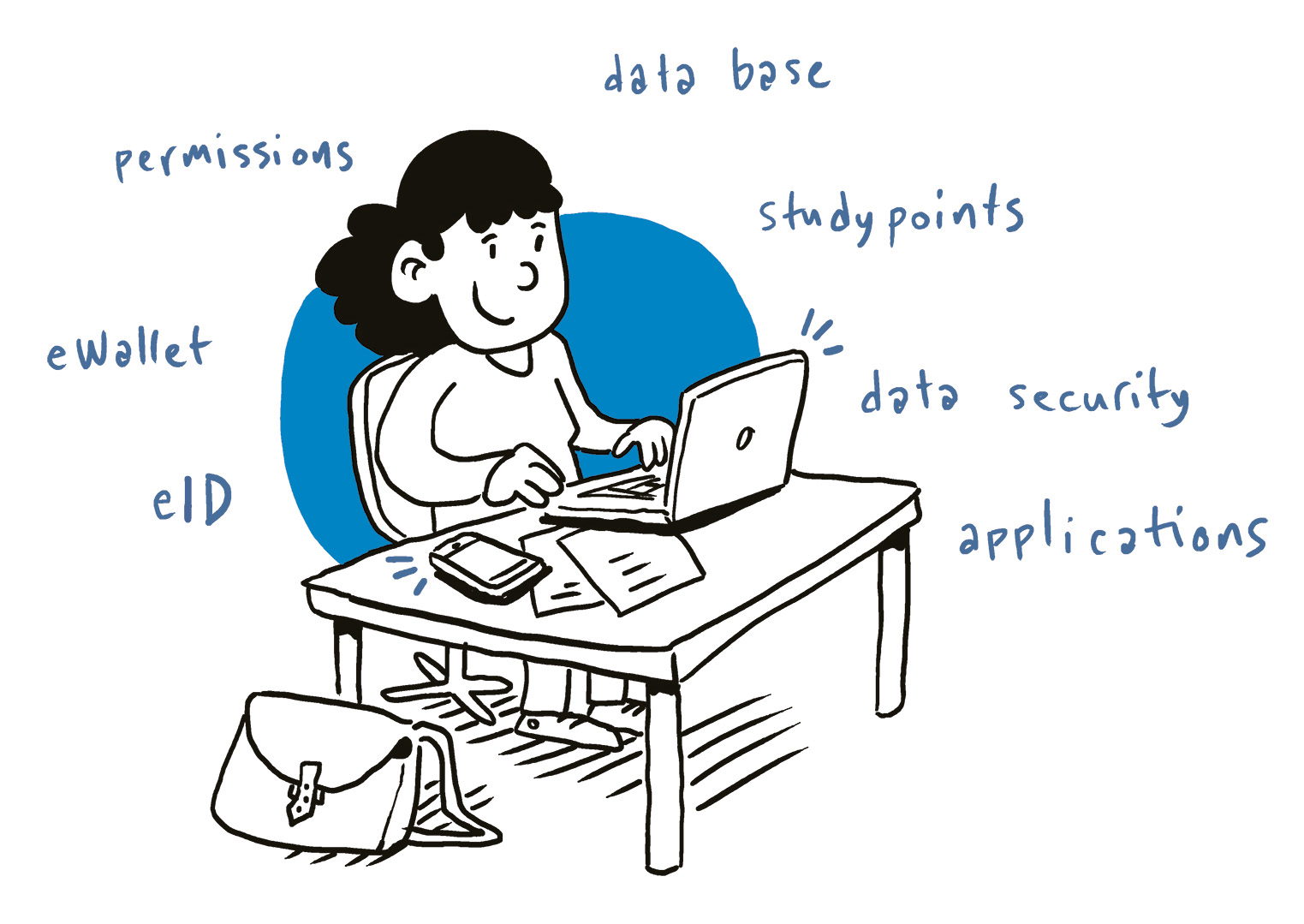1. Introduction
The Nordic Council of Ministers has a vision of the Nordic region being the most sustainable and integrated region in the world by 2030.
Already today, people frequently move and travel from one Nordic or Baltic country to another for reasons related to work, studies, and family. Together the Nordic and Baltic countries form an active region, even by global standards, where it is important to ensure that not only people and businesses but also data moves in an agile manner across borders. Hence the goal of regional integration is mutual for the Nordic and Baltic countries.
Certain border regions in the Nordic and Baltic countries already witness especially close and active cross-border cooperation, where everyday life revolves around working, living and consuming services on both sides of the border. In this handbook they are called “hot spot” areas. While the degree of integration varies depending on the region, the regions are tied together economically, culturally, and linguistically, and are often formed by a long, mutual history.
Certain border regions in the Nordic and Baltic countries already witness especially close and active cross-border cooperation, where everyday life revolves around working, living and consuming services on both sides of the border. In this handbook they are called “hot spot” areas. While the degree of integration varies depending on the region, the regions are tied together economically, culturally, and linguistically, and are often formed by a long, mutual history.
The cross-border mobility of people sets new demands on digitalisation. As a person moves from one country to another, whether for a longer or a shorter period, there is an increasing need for information on the social system, healthcare services, taxation, and various public services in the country of destination, as well as the use of a person’s healthcare information and educational credentials, for example. In the modern digital world, all the relevant information should be made more easily, more comprehensively, and more accurately available for citizens, companies, and public administrations.
The Nordic and Baltic countries aim to be the first region in the world to follow the ‘cross-border by default’ principle in all development of digital services. During the Finnish Presidency in 2021, the Nordic Council of Ministers launched a three-year project, Achieving the World’s Smoothest Cross-Border Mobility and Daily Life through Digitalisation,

Figure 1. "Hot spot" areas in the Nordic and Baltic countries.
To gather a general understanding of the current situation of cross-border data exchange in the Nordic and Baltic countries and their shared everyday life, the project started by conducting a baseline study in 2021 focusing on three selected life events. The life events were further studied during the project as project work packages.
The selected life events were:
- Studying in another Nordic or Baltic country
- The use of health services in another Nordic or Baltic country
- The versatile use of Nordic and Baltic legal databases
The baseline study investigated the key parties, data exchange needs and requirements, current services and data repositories, and bottlenecks for data exchange from the perspective of cross-border everyday lives of people and businesses. In the baseline study the data interoperability was assessed through European Interoperability Framework (EIF)’s layers: legal, organisational, semantic, and technical interoperability.

1.1 Why this handbook
This handbook aims to summarise the findings of the three-year project into a compact and coherent form, utilising the project deliverables, events and working groups as well as interviews conducted in relation to this project. The aim is to provide the reader with insights and ideas for future development by pinpointing identified networks, interesting initiatives, and potential funding mechanisms, as well as highlighting case examples that could be utilised in the development of cross-border collaboration in different fields and on different levels.
This handbook is not the final report of the project. The handbook does not report the project timeline, workshop participants, nor the fruitful discussions or even the inspiring interviews. The actual project deliverables are described in detail in separate reports that can be found through the project website
- Baseline study of cross-border data exchange
- Overview of potential funding
- Overview of machine translation services
- Cost-benefit analysis of improved cross-border digital services for studying abroad
- Cost-benefit analysis of cross-border healthcare data exchange
- Legislative data proof-of-concept
- FI-Platform—Interoperability training material, describing technical interoperability
- Review of data exchange concerning population data registration
- Workshop documentation
The overall goal of this handbook is to draw a big picture on cross-border data exchange. The handbook is about highlighting the interesting initiatives and pinpointing existing standards and networks to help organisations and professionals more easily take cross-border aspects into consideration when developing either processes, responsibilities, or IT systems.
The handbook also wants to encourage Nordic-Baltic officials in all fields to actively participate in European development activities on multiple levels. That is the way the Nordic-Baltic voice will get best heard in policymaking on both national and international levels.

This handbook especially aims to support all Nordic-Baltic officials who
- are developing processes or information systems within their own organisations,
or between organisations within one or many countries, or - are promoting digitalisation on the national or international level (policymaking).
1.2 The structure of this handbook
This handbook is a collection of some of the most interesting themes, topics, and case examples from the Nordic-Baltic countries concerning cross-border data exchange. The handbook is not a full manual on data exchange but rather aims at guiding the reader towards interesting sources, materials, and networks. The pinpointed website links will become obsolete at some point, but the names of the standards, networks, and initiatives will hopefully guide the reader forward even after a while. With that said, the handbook aims to encourage readers to be curious and active and to participate in collaboration on different levels, both nationally and internationally!
The reader of this handbook can choose the most suitable way of using the handbook: the structure is designed so it can be read as one book, or the reader can pick headlines that are of interest at a specific point in time.
Here are short descriptions of the chapters of this handbook:
Chapter 2 The ballpark and the key players describes the framework: what we already know, what the playground is currently like, who the key players are, and with whom the reader might want to continue the game.
Chapter 3 Findings of work package 1: Studying in another Nordic or Baltic country highlights the key findings of the project work package 1, what has been done in the field of supporting student mobility through digitalisation, and where the Nordic-Baltic as well as EU level development seems to be heading.
Chapter 4 Findings of work package 2: Use of health services in another Nordic or Baltic country highlights case examples in the healthcare sector and the future development steps in the implementation of e-prescriptions and cross-border exchange of patient summaries.
Chapter 5 Findings of work package 3: Versatile use of the Nordic and Baltic legal databases suggests that while legal information may not be needed to transfer with people from country to another, machine readable legislative data would help provide Nordic-Baltic as well as EU citizens with real-time info on valid national legislation that could influence anyone working or studying in another country.
The scope of this project was on three pre-selected points-of-view, but the project group hopes this handbook will give food for thought to other sectors as well. The challenges of cross-border data exchange are similar although case examples vary.
References
- Nordic Council of Ministers. (2021). Our Vision 2030. Available: https://www.norden.org/en/our-vision-2030. Cited 7.7.2023.
- Finnish Ministry of Finance. (2021). World’s smoothest cross-border mobility and daily life through digitalization. Available: https://vm.fi/en/world-s-smoothest-cross-border-mobility-and-daily-life-through-digitalisation. Cited 7.7.2023.
- World’s Smoothest Cross-Border Mobility and Daily Life Through Digitalisation. (2023). Project website for workshop materials. Available: https://wiki.dvv.fi/pages/viewpage.action?pageId=117377490. Cited 18.7.2023.
- Nordic Council of Ministers. (2021). Baseline study of cross-border data exchange in the Nordic and Baltic countries. Available: https://www.norden.org/en/publication/baseline-study-cross-border-data-exchange-nordic-and-baltic-countries. Cited 7.7.2023.